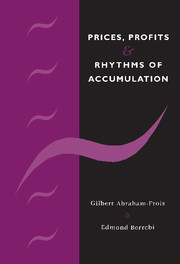Book contents
- Frontmatter
- Contents
- Preface
- 1 The golden rule of accumulation and prices
- 2 Systems of production prices
- 3 Irregular and decomposable systems
- 4 The analysis of joint production
- 5 Standards and blocking goods
- 6 Labour values and the problem of transformation
- 7 Switch in methods of production
- 8 The dynamic evolution
- Notes
- References
- Index
8 - The dynamic evolution
Published online by Cambridge University Press: 06 July 2010
- Frontmatter
- Contents
- Preface
- 1 The golden rule of accumulation and prices
- 2 Systems of production prices
- 3 Irregular and decomposable systems
- 4 The analysis of joint production
- 5 Standards and blocking goods
- 6 Labour values and the problem of transformation
- 7 Switch in methods of production
- 8 The dynamic evolution
- Notes
- References
- Index
Summary
Up to now our analyses have been carried out within a timeless context; we have enhanced the structures of prices, at given r or g, and the corresponding wage rates, on the one hand, and the activity structures and the resulting consumption levels, on the other hand; thus we have dealt with structures and not with change.
We shall first address the dynamic evolution of prices and quantities by assuming constant returns to scale. Then we shall analyse the accumulation process in a more general context with some activities using natural resources, land whose availability is limited thus creating a scarcity constraint. The regulating price of wheat, and more generally of the good produced in increasingly costly conditions, will be fixed by the most costly method of cultivation. The land using that method being first considered as over abundant shall have a zero price and its owner will divert no profit from it. As far as the other lands are concerned, we shall show that their owners divert from them differential rents which are residual: lands and methods of cultivation are closely related and are at the heart of our analysis. Within the same framework, we shall analyse the consequences of the introduction of new techniques or changes in the methods of production.
When the ‘land’ using the most costly method of cultivation is fully used, the rent phenomenon becomes general; intensive cultivation entails the appearance of positive rents for all natural resources; then the prices of ‘wheat’ and ‘land’ (and thus the intensive rent) are determined simultaneously. Therefore, the determination of prices is deeply altered by scarcity.
- Type
- Chapter
- Information
- Prices, Profits and Rhythms of Accumulation , pp. 217 - 262Publisher: Cambridge University PressPrint publication year: 1997



